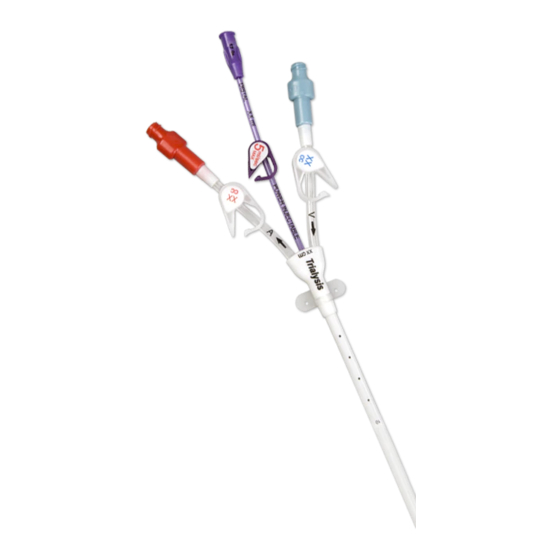
Advertisement
Advertisement
Table of Contents

Summary of Contents for Bard Power-Trialysis
- Page 1 ™ ™ Short-Term Dialysis Catheters Instructions For Use Bard Access Systems, Inc. 605 North 5600 West Salt Lake City, UT 84116 USA 1-801-522-5000 Bard Access Systems, Inc. Clinical Information Hotline: 1-800-443-3385 Ordering Information: 1-800-545-0890 www.bardaccess.com 0736073 / 1502R...
- Page 2 Close clamp and replace the end cap on the catheter. Description Power-Trialysis™ Short-Term Dialysis Catheters are made of thermosensitive polyurethane, which softens when exposed to body tempera- ture. The catheter is divided into three separate lumens permitting continuous blood flow. Both the venous (blue) and the arterial (red) lumens may be used for hemodialysis, hemoperfusion, and apheresis treatments.
-
Page 3: Indications For Use
Indications For Use The Power-Trialysis™ Short-Term Dialysis Catheter, with a third internal lumen for intravenous therapy, power injection of contrast media, and central venous pressure monitoring, is indicated for use in attaining short-term (less than 30 days) vascular access for hemodialysis, hemoperfusion, and apheresis treatments. - Page 4 Warnings (cont.) • To avoid damage to vessels and viscus, prolonged infusion pressures must not exceed 25 psi (172 kPa). The use of a 10 mL or larger syringe is recommended because smaller syringes generate more pressure than larger syringes. NOTE: A three pound (13.3 Newton) force on the plunger of a 3 mL syringe generates pressure in excess of 30 psi (206 kPa) whereas the same three pound (13.3 Newton) force on the plunger of a 10 mL syringe generates less than 15 psi (103 kPa) of pressure.
-
Page 5: Possible Complications
Possible Complications The use of an indwelling central venous catheter provides an important means of venous access for critically ill patients; however, the potential exists for serious complications including the following: • Air Embolism • Endocarditis • Pneumothorax • Arterial Puncture •... -
Page 6: Care And Maintenance
Holding the guidewire securely in place, remove the introducer needle. CAUTION: Do not allow the guidewire to inadvertently advance totally into the vessel. The introducer needle tract is widened by creating a small surgical incision at the skin exit site. The incision should be slightly larger than the wide/flat side of the catheter. -
Page 7: Troubleshooting
Exit Site Cleaning • Use aseptic technique (as outlined above). • Clean the exit site at each dialysis treatment with chlorhexidine gluconate unless contraindicated. Apply antiseptic per manufacturer’s recommendations. Allow to air dry completely. • Cover the exit site with sterile, transparent, semipermeable dressing or per hospital protocol. Recommended Cleaning Solutions Catheter Luer-lock Exit Site:... - Page 8 ™ Flow Performance Guidelines For Bard Access Systems Power-Trialysis Short-Term Dialysis Catheter Performance Guidelines: (As suggested by In Vitro data) Power Injection Flow Information (Injection pressure should be set at a maximum of 300 psi) Center Lumen Average Max Catheter...
- Page 9 Bard Access Systems, Inc. warrants to the original purchaser that this product will be free from defects in material and workmanship for a period of one (1) year from the date of purchase. If this product proves to be so defective, purchaser may return same to Bard Access Systems, Inc.











Need help?
Do you have a question about the Power-Trialysis and is the answer not in the manual?
Questions and answers